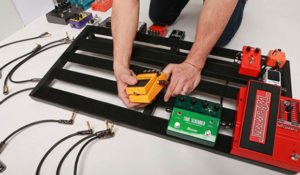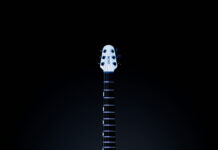
Tips on Building Your Pedalboard
So, you’ve got the chops, you’ve figured out the scales, you even have the gear to back up your skills. But if you’re going to hit the road, play the bars or present yourself as half-professional, you’re going to need a way to organize your pedals.
That’s right, we’re talking pedal boards. There is a method to setting them up, and everyone is different.
Obviously it’s more than just drilling a bunch of pedals to a plank of wood and plugging them in. I spoke with Aleric Bendowski, accessories department manager at Guitar Center in Salt Lake City, Utah, and Mason Bundshu, lead guitar player for Las Vegas-based rock band Atlas Takes Aim, and learned there are a few things to keep in mind.
The first thing you have to think about is a case. It is possible to buy pre-made pedal cases like the Boss BCB60 Pedal Board Case, but that can lock you down in terms of options. You can go fully custom and design your own, and if you’re good with a miter saw, there is no end to the customization.
But if you’re like most of us, a hand-built piece of fabric-covered plywood can be perfect. It’s plentiful, inexpensive and easy to work with. But a piece of plywood is not a case, and it isn’t waterproof, either, as Bendoski points out.
You can find a DJ CD Case like the SKB 1717DJ ATA 400-CD Hardshell DJ Disc Case or a turntable case like the Gemini CDM2, cut out any opposing dividers, and you have your template for a piece of plywood. Buying a pre-made case can cut down your cost, increase stage appeal and give your otherwise homeless pedals a home. Plus most will have handles and be road-worthy at once.
Power delivery needs to be your next thought. Ideally you want one power chord to plug in the wall that will power your board. You really have two options: Power supply or daisy chain.
If you go with something like the Dunlop DC-Brick, you’re going to get a cleaner sound. But let’s face it, cost is an issue, and daisy chaining has its place too. This is common, normal and acceptable, but you can run into some issues with frequency, volume and overall sound-quality loss. If quality is a concern and you have more than three pedals, it is worth going with the brick option.
Now we come to pedal placement—an art form in itself. I’ve heard everything from mandates ordering which pedals MUST be placed where, to complete laissez-faire approaches.
There are, of course, good ideas and bad ideas, but in the end it comes down to your individual taste. You must experiment since pedals can interfere with one another, sometimes in good ways and other times in very bad ways. And it can change in a live environment compared to a studio situation.
That said, I present the following order (from guitar to pedals to amp) as a starting point:
• Tuner pedals (Really this can be first or last)
• Compression pedals
• Wah pedal: Some INSIST this must go first since it needs a direct line feed but there can be a time and place to place it further down.
• Pitch-modification pedals
• Distortion
• Modulation pedals
• Light modulation like chorus and flangers first
• Heavy modulation like phasers and vibrato second
• Delay
• Reverb
Next we come to cable selection. Cables are the oil that make this engine run. If you’ve been playing a while and know your way around a soldering iron, it can be a great idea to go with George L or Planet Waves solderless cables. Less decibel loss and signal degradation but higher cost.
But since money and time are limited, it is plenty sufficient to use off-the-shelf chords. That being said, if you are at all serious about your pedal board, don’t cheap-out on the chords. Garbage in, garbage out! Spend some money on chords and make them count.
I’ve presented a very rough outline of what to plan for as you build your pedal board. Remember, the key is to know the rules so that you can break them the right way. You might set your board up like I’ve described here and change it in four months. That’s OK! Have fun, you will learn as you go.
No one ever sits back and says, “There! I have built the perfect pedal board.” This is art in progress. Build your pedal board to your taste.
Craig Greenwood was born in Kansas City, grew up in Salt Lake City and has lived in Nashville, working in radio and in recording studios. He has played drums and guitar for more than 20 years.
Source: www.guitarworld.com










